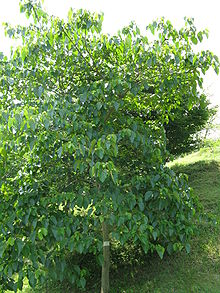| Vernicia fordii | |
|---|---|

| |
| Scientific classification | |
| Kingdom: | Plantae |
| Clade: | Tracheophytes |
| Clade: | Angiosperms |
| Clade: | Eudicots |
| Clade: | Rosids |
| Order: | Malpighiales |
| Family: | Euphorbiaceae |
| Genus: | Vernicia |
| Species: | V. fordii
|
| Binomial name | |
| Vernicia fordii | |
| Synonyms | |
|
Aleurites fordii Hemsl. | |
Vernicia fordii (usually known as the tung tree (Chinese: 桐, tóng) and also as the tung-oil or tungoil tree (油桐), the kalo nut tree, and the China wood-oil tree) is a species of flowering plant in the spurge family native to southern China, Myanmar, and northern Vietnam.[1] It is a small to medium-sized deciduous tree growing to 20 m tall, with a spreading crown. The bark is smooth and thin, and bleeds latex if cut. The leaves are alternate, simple, 4.5–25 cm long and 3.5–22 cm broad, heart-shaped or with three shallow, maple-like lobes, green above and below, red conspicuous glands at the base of the leaf, and with a 5.5–26 cm long petiole. The flowers are 2.5–3.5 cm diameter, with five pale pink to purple petals with streaks of darker red or purple in the throat; it is monoecious with individual flowers either male or female, but produced together in the inflorescences. The flowers appear before or with the leaves in loose, terminal clusters. The fruit is a hard, woody pear-shaped berry 4–6 cm long and 3–5 cm diameter, containing four or five large, oily seeds; it is green initially, becoming dull brown when ripe in autumn.[1][2]
- ^ a b Stuppy, W.; van Welzen, P. C.; Klinratana, P.; Posa, M. C. T. "86. Vernicia". Flora of Thailand - Euphorbiaceae. Netherlands: National Herbarium.
- ^ "Vernicia fordii - Tung Oil Tree". Florida Nature.